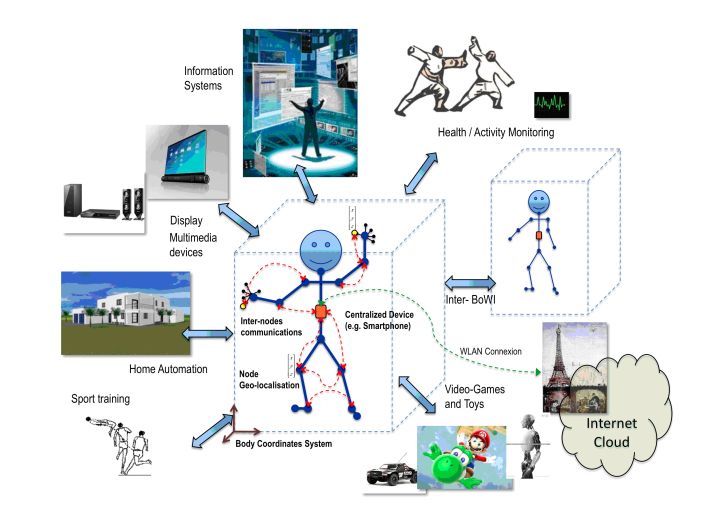BoWI: Body World Interaction
Towards an accurate gesture and body movement estimation using very-small and low-power wearable sensor nodes
NEW: Executive Summary (pdf version)
Overview
The BoWi project stands for Body World Interactions and intially stems from a proposal of the CominLabs think thank focused on the society challenge called Digital Environment for the Citizen. It is also related to the social challenge ICT for Personalized Medicine and to the research track Energy Efficiency in ICT.
The main objective of the project is the design of pioneer interfaces for an emerging interacting world based on smart environments (house, media, information and entertainment systems…). Basically the project relies on Wireless Body Areas Sensor Networks; the aim is the accurate Gesture and Body Movement estimation with extremely severe constraints in terms of footprint and power consumption according to on-body energy harvesting perspectives. The BoWI geolocation approach will combine radio communication distance measurement and inertial sensors and it will also strongly benefit from cooperative techniques based on multiple observations and distributed computation. Different types of applications, as health care, activity monitoring and environment control, will be considered and evaluated along with a human-machine interface expertise.
Scientific Challenges
The first scientific challenge is global and deals with the solution to be interactively invented by all partners: a short-range geolocation method based on distributed and coopering devices processing multisource data issued from radio-communication distance estimation and integrated inertial sensors. It includes several specific contributions:
- Dynamic and cooperative communication coding and protocol for inter-nodes communications. This includes cooperative communications and protocols such as cooperative MIMO, relaying, error coding, network coding and MAC and wake-up radio protocols.
- Node hardware/software architecture design and self-adaptive distributed processing for geolocation with aggressive low-power run-time optimisation.
- Channel models and antennas for short-range communications. This study will be performed for various radio standards from upcoming BAN {802.15.6, 802.15.4a} technologies to future UWB solutions.
- Channel models and antennas for WBASN at millimeter waves. This is a promising perspective for antenna miniaturization, however no front-ends are yet available.
- In depth and specific analysis of human-machine interactions to set system constrains and define user requirement according to various application perspectives.
- Development of a simulator and body-sensor-network platform for virtual and real prototyping of BoWI concept.
Expected results
In practice the BoWi partners aim to deliver the design of basic components, a prototype based on available radio front-ends and energy harvesting devices as well as a system simulator including mm-wave models. Results will also concern the specification of future radio-front ends.
BoWI team
The BoWI team is composed of academic staff of University of Rennes 1, INRIA, UBS University, Telecom Bretagne and INSA engineering scools membres of three CNRS labs located in Brittany IRISA (Lannion, Rennes), IETR (Rennes) and Lab-STICC (Brest, Lorient, Vannes).
Olivier Sentieys (IRISA/INRIA), Jean-Philippe Diguet (Lab-STICC), Ronan Sauleau (IETR), Charlotte Langlais (Lab-STICC), Olivier Berder (IRISA/INRIA), Christian Roland (Lab-STICC), Frank Poirier (Lab-STICC), Christian Person (Lab-STICC), Pascal Scalart (IRISA/INRIA).

